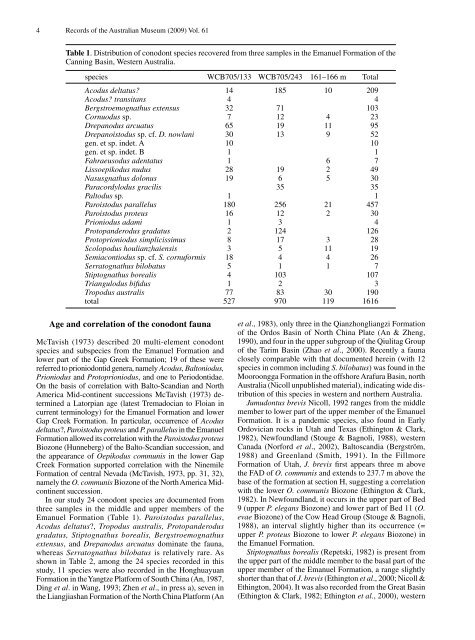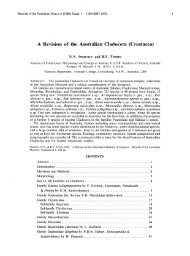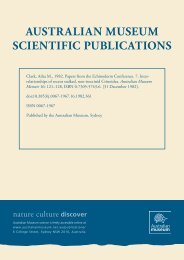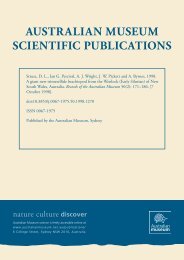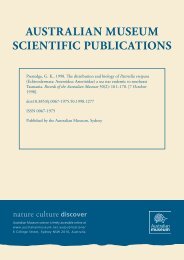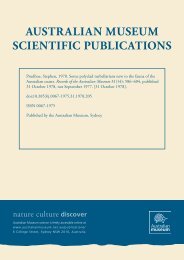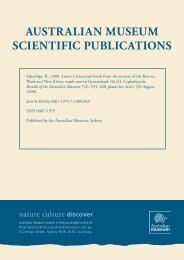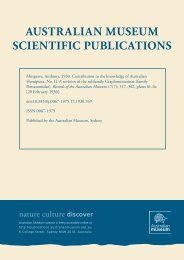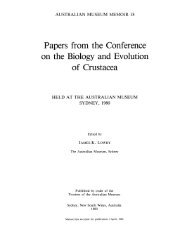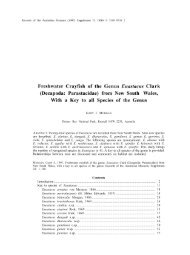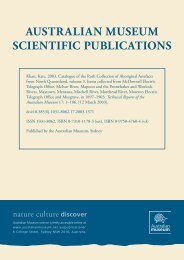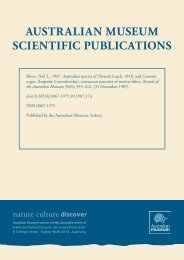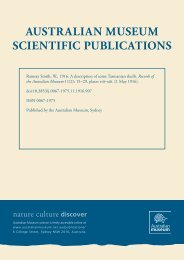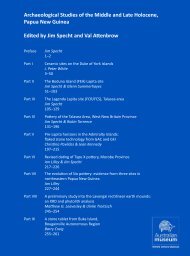Biogeographic and biostratigraphic implications of the - Australian ...
Biogeographic and biostratigraphic implications of the - Australian ...
Biogeographic and biostratigraphic implications of the - Australian ...
You also want an ePaper? Increase the reach of your titles
YUMPU automatically turns print PDFs into web optimized ePapers that Google loves.
4 Records <strong>of</strong> <strong>the</strong> <strong>Australian</strong> Museum (2009) Vol. 61<br />
Table 1. Distribution <strong>of</strong> conodont species recovered from three samples in <strong>the</strong> Emanuel Formation <strong>of</strong> <strong>the</strong><br />
Canning Basin, Western Australia.<br />
species WCB705/133 WCB705/243 161–166 m Total<br />
Acodus deltatus? 14 185 10 209<br />
Acodus? transitans 4 4<br />
Bergstroemognathus extensus 32 71 103<br />
Cornuodus sp. 7 12 4 23<br />
Drepanodus arcuatus 65 19 11 95<br />
Drepanoistodus sp. cf. D. nowlani 30 13 9 52<br />
gen. et sp. indet. A 10 10<br />
gen. et sp. indet. B 1 1<br />
Fahraeusodus adentatus 1 6 7<br />
Lissoepikodus nudus 28 19 2 49<br />
Nasusgnathus dolonus 19 6 5 30<br />
Paracordylodus gracilis 35 35<br />
Paltodus sp. 1 1<br />
Paroistodus parallelus 180 256 21 457<br />
Paroistodus proteus 16 12 2 30<br />
Prioniodus adami 1 3 4<br />
Protop<strong>and</strong>erodus gradatus 2 124 126<br />
Protoprioniodus simplicissimus 8 17 3 28<br />
Scolopodus houlianzhaiensis 3 5 11 19<br />
Semiacontiodus sp. cf. S. cornuformis 18 4 4 26<br />
Serratognathus bilobatus 5 1 1 7<br />
Stiptognathus borealis 4 103 107<br />
Triangulodus bifidus 1 2 3<br />
Tropodus australis 77 83 30 190<br />
total 527 970 119 1616<br />
Age <strong>and</strong> correlation <strong>of</strong> <strong>the</strong> conodont fauna<br />
McTavish (1973) described 20 multi-element conodont<br />
species <strong>and</strong> subspecies from <strong>the</strong> Emanuel Formation <strong>and</strong><br />
lower part <strong>of</strong> <strong>the</strong> Gap Greek Formation; 19 <strong>of</strong> <strong>the</strong>se were<br />
referred to prioniodontid genera, namely Acodus, Baltoniodus,<br />
Prioniodus <strong>and</strong> Protoprioniodus, <strong>and</strong> one to Periodontidae.<br />
On <strong>the</strong> basis <strong>of</strong> correlation with Balto-Sc<strong>and</strong>ian <strong>and</strong> North<br />
America Mid-continent successions McTavish (1973) determined<br />
a Latorpian age (latest Tremadocian to Floian in<br />
current terminology) for <strong>the</strong> Emanuel Formation <strong>and</strong> lower<br />
Gap Creek Formation. In particular, occurrence <strong>of</strong> Acodus<br />
deltatus?, Paroistodus proteus <strong>and</strong> P. parallelus in <strong>the</strong> Emanuel<br />
Formation allowed its correlation with <strong>the</strong> Paroistodus proteus<br />
Biozone (Hunneberg) <strong>of</strong> <strong>the</strong> Balto-Sc<strong>and</strong>ian succession, <strong>and</strong><br />
<strong>the</strong> appearance <strong>of</strong> Oepikodus communis in <strong>the</strong> lower Gap<br />
Creek Formation supported correlation with <strong>the</strong> Ninemile<br />
Formation <strong>of</strong> central Nevada (McTavish, 1973, pp. 31, 32),<br />
namely <strong>the</strong> O. communis Biozone <strong>of</strong> <strong>the</strong> North America Midcontinent<br />
succession.<br />
In our study 24 conodont species are documented from<br />
three samples in <strong>the</strong> middle <strong>and</strong> upper members <strong>of</strong> <strong>the</strong><br />
Emanuel Formation (Table 1). Paroistodus parallelus,<br />
Acodus deltatus?, Tropodus australis, Protop<strong>and</strong>erodus<br />
gradatus, Stiptognathus borealis, Bergstroemognathus<br />
extensus, <strong>and</strong> Drepanodus arcuatus dominate <strong>the</strong> fauna,<br />
whereas Serratognathus bilobatus is relatively rare. As<br />
shown in Table 2, among <strong>the</strong> 24 species recorded in this<br />
study, 11 species were also recorded in <strong>the</strong> Honghuayuan<br />
Formation in <strong>the</strong> Yangtze Platform <strong>of</strong> South China (An, 1987,<br />
Ding et al. in Wang, 1993; Zhen et al., in press a), seven in<br />
<strong>the</strong> Liangjiashan Formation <strong>of</strong> <strong>the</strong> North China Platform (An<br />
et al., 1983), only three in <strong>the</strong> Qianzhongliangzi Formation<br />
<strong>of</strong> <strong>the</strong> Ordos Basin <strong>of</strong> North China Plate (An & Zheng,<br />
1990), <strong>and</strong> four in <strong>the</strong> upper subgroup <strong>of</strong> <strong>the</strong> Qiulitag Group<br />
<strong>of</strong> <strong>the</strong> Tarim Basin (Zhao et al., 2000). Recently a fauna<br />
closely comparable with that documented herein (with 12<br />
species in common including S. bilobatus) was found in <strong>the</strong><br />
Mooroongga Formation in <strong>the</strong> <strong>of</strong>fshore Arafura Basin, north<br />
Australia (Nicoll unpublished material), indicating wide distribution<br />
<strong>of</strong> this species in western <strong>and</strong> nor<strong>the</strong>rn Australia.<br />
Jumudontus brevis Nicoll, 1992 ranges from <strong>the</strong> middle<br />
member to lower part <strong>of</strong> <strong>the</strong> upper member <strong>of</strong> <strong>the</strong> Emanuel<br />
Formation. It is a p<strong>and</strong>emic species, also found in Early<br />
Ordovician rocks in Utah <strong>and</strong> Texas (Ethington & Clark,<br />
1982), Newfoundl<strong>and</strong> (Stouge & Bagnoli, 1988), western<br />
Canada (Norford et al., 2002), Baltosc<strong>and</strong>ia (Bergström,<br />
1988) <strong>and</strong> Greenl<strong>and</strong> (Smith, 1991). In <strong>the</strong> Fillmore<br />
Formation <strong>of</strong> Utah, J. brevis first appears three m above<br />
<strong>the</strong> FAD <strong>of</strong> O. communis <strong>and</strong> extends to 237.7 m above <strong>the</strong><br />
base <strong>of</strong> <strong>the</strong> formation at section H, suggesting a correlation<br />
with <strong>the</strong> lower O. communis Biozone (Ethington & Clark,<br />
1982). In Newfoundl<strong>and</strong>, it occurs in <strong>the</strong> upper part <strong>of</strong> Bed<br />
9 (upper P. elegans Biozone) <strong>and</strong> lower part <strong>of</strong> Bed 11 (O.<br />
evae Biozone) <strong>of</strong> <strong>the</strong> Cow Head Group (Stouge & Bagnoli,<br />
1988), an interval slightly higher than its occurrence (=<br />
upper P. proteus Biozone to lower P. elegans Biozone) in<br />
<strong>the</strong> Emanuel Formation.<br />
Stiptognathus borealis (Repetski, 1982) is present from<br />
<strong>the</strong> upper part <strong>of</strong> <strong>the</strong> middle member to <strong>the</strong> basal part <strong>of</strong> <strong>the</strong><br />
upper member <strong>of</strong> <strong>the</strong> Emanuel Formation, a range slightly<br />
shorter than that <strong>of</strong> J. brevis (Ethington et al., 2000; Nicoll &<br />
Ethington, 2004). It was also recorded from <strong>the</strong> Great Basin<br />
(Ethington & Clark, 1982; Ethington et al., 2000), western


